


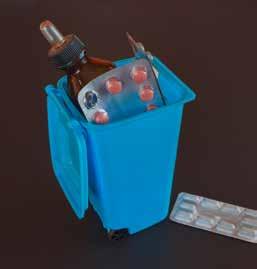





While the rollout of the vaccine has been a relief for the nation’s teachers, many of whom have been working in-person on and off since the start of the pandemic, the reality is that not everyone will get the vaccine. What’s more, being in the school building all day with children who are not yet approved for immunization leaves many educators and school staff vulnerable to COVID-19, no matter how many precautions they take while off the clock.
But there’s good news: new scientific breakthroughs are helping make schools safer by protecting surfaces for far longer than routine cleaning, which does so only momentarily.
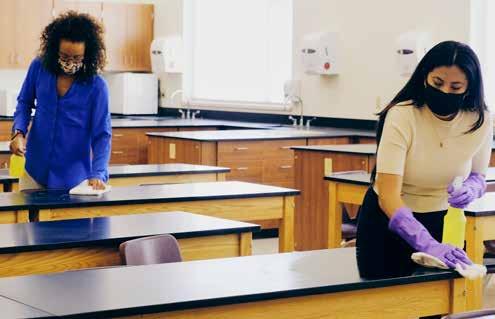
Human coronaviruses can persist on inanimate surfaces such as plastic, glass, fibers and metals for up to nine days, according to the National Institutes of Health. While routine cleaning and disinfection help, they leave surfaces immediately vulnerable to recontamination, particularly in highly trafficked areas like break rooms, desks, lockers, and especially school and classroom entrances. Traditional disinfectants alone can’t guarantee full coverage, protect for long periods, or even prevent recontamination. On top of that, the burden of constantly reapplying momentary disinfectants throughout the day
has largely fallen on teachers, many of whom are paying for cleaning supplies out of their own paychecks.
In keeping America’s teachers safe, standard cleaning methods alone can only do so much. A new EPA-approved product, however, when used as directed, offers continuous protection from COVID-19 with a single application, making school safety more reliable and efficient. The product, SurfaceWise2, was developed by
biotechnology company Allied BioScience, which has a mission of reducing the footprint of global infection caused by the transmission of microorganisms encountered in daily life.
“The pandemic has put more responsibilities on schools than ever before, and our teachers are stretched thin,” says Jess Hilton, chief marketing officer, Allied BioScience. “Providing additional safety measures for this sometimes overlooked frontline worker group is critical.”
As leading infectious disease expert Dr. Charles P. Gerba explains, schools have always been a major germ transfer zone, and the pandemic has only elevated this health and safety risk.
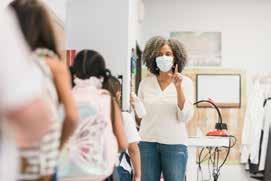
“The average child touches their face about 40 to 50 times per hour,” says Dr. Gerba. “Having a reliable way to protect surfaces for long periods of time is essential.”
Independent lab studies conducted by Dr. Gerba found SurfaceWise2 to be effective against Human Coronavirus 229E, the EPA-approved surrogate, demonstrating the ability to successfully protect against COVID-19. Coated surfaces were found to reduce the concentration of these viruses by greater than 99.9% within two hours of contact.
SurfaceWise2 has undergone rigorous reviews and extensive safety testing, carrying the lowest possible EPA toxicity rating making it safe to use in enclosed spaces, which is critical as teachers must work inside the classroom. The coating is non-toxic, non-irritating, and contains no chemicals that produce harmful vapors or gases. To learn more, visit www. surfacewise.com.
“Alongside precautions like mask-wearing and social distancing, effective longterm coatings to protect surfaces can allow schools to better keep their teachers safe, and help make the choice between safety and livelihood a little easier for America’s educators,” says Hilton.
Source: StatePoint
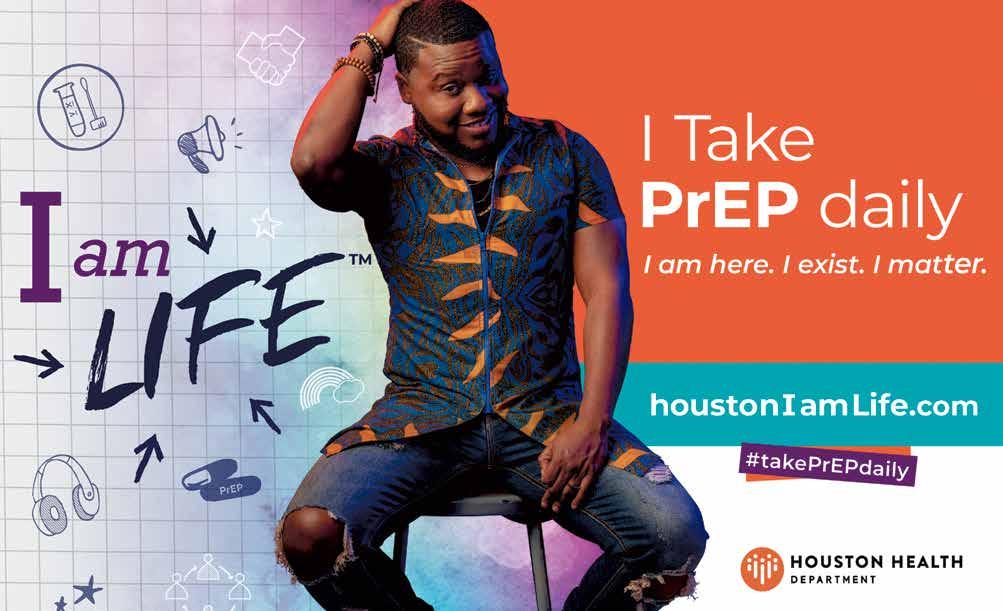

With your mind on the changing season, you may be purging closets, vacuuming floors and washing windows - but there's one crucial area of the house to keep in mind: your medicine cabinet. Every year, unused prescriptions and expired over-thecounter medicines clutter bathrooms, kitchen cupboards and drawers, posing a danger to everyone in your household. Now is a great time to clear out this safety hazard from your home, and do it in a way that's also environmentally responsible.
Americans are prescribed billions of medications, but according to Research in Social and Administrative Pharmacy, approximately two-thirds of those pills go unused. Leaving unfinished prescriptions in your home poses a danger not only to children, but also to adults or teens who may be tempted to try the medications, or give or sell them to others. Nearly half of adolescents 12 and over who report misusing prescription pain relievers took or received the drugs from a friend or relative.
Over-the-counter medications also pose a hazard, especially to children. The CDC reports that approximately 60,000 young children are brought to the emergency room each year because they accessed medicines that were within reach or not disposed of properly. Make sure medications and supplements are safely stored up and away, in child-proof containers. Check all medications, including vitamins and supplements, for expiration dates, as expired medications may not only be ineffective, but potentially unsafe.
There is a lot of misinformation about how to dispose of prescription and overthe-counter medications without causing harm to people or the environment. Some counties sponsor drug take-back days or offer drop boxes, that allow you to bring in medications that you want to discard.
Unfortunately, not everyone has access to a drop-off site; that's where at-home disposal is a useful option. If you want to safely and easily discard old medications and render them harmless at the same time, Deterra Drug Deactivation System Pouches are the only at-home medication disposal system that permanently
deactivates over-the-counter and prescription medications. It is the safest, most effective choice to destroy and dispose of unused and expired medications. The pouches use activated carbon and tap water to render any medications inactive.
Environmentally sound disposal methods

Concerned about the environment while you clear out your prescriptions?
In the past, many thought disposing of medications by flushing them down the toilet or throwing them in the trash was acceptable. However, it is clear that many ingredients in medications can pollute water and soil.
Activated carbon is organic, chemical-free and, once used, makes medication safe for disposal in normal household trash. Plus, it prevents harmful medications from contaminating landfills and water systems. Deterra pouches themselves are USDA-certified biobased, made from 50% or more plant-based material and manufactured in a factory using 100% wind generated power. When you're discarding your medications, don't forget the bottles. Check containers for a recycling symbol, and consult your local recycling service for guidelines. Remove or obscure personal information on prescription labels, then rinse and dry containers to remove any residue before recycling.
Since 2020, Deterra has partnered with SAFE Project, a national nonprofit working to end addiction, on the Gone for Good campaign, a pouch giveaway to help prevent medication misuse and increase access to at-home disposal resources. Admiral James and Mary Winnefeld founded SAFE Project after the tragic loss of their 19-year-old son Jonathan to an accidental opioid overdose.
"It's so important for families to be aware of this issue, and to do whatever they can to keep family members safe," said Admiral Winnefeld. "Regularly removing substances that could potentially be misused is one way to help protect everyone in your household from this very real danger."
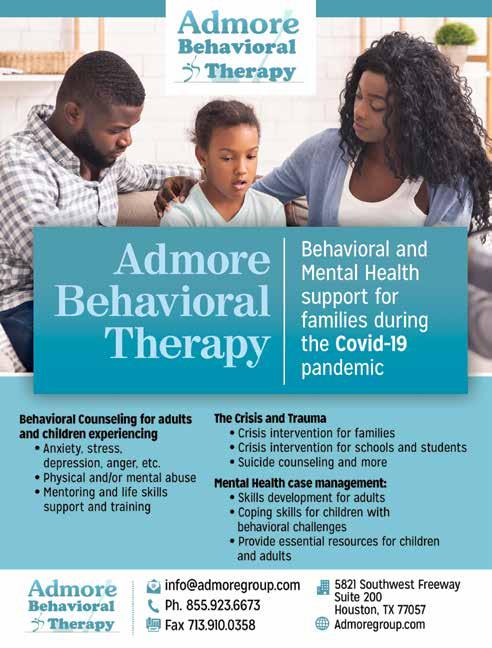
The April 2021 Gone for Good campaign will distribute 20,000 free at-home drug disposal pouches to U.S. households. Anyone in the continental United States can request a free pouch be mailed to them at DeterraSystem.com/SAFE.
Source: BPT


You’re cleansing your skin daily, using sunscreen, trying to eat right and exercise to keep your healthy, youthful appearance. But despite your best efforts, those small and unsightly dark bumps on your forehead, cheeks, chin, neck, or around your eyes are a stubborn nuisance — and you can’t hide them with makeup.
Dermatosis Papulosa Nigra, better known as moles, are black or brown bumps that often start showing up during adolescence and tend to grow bigger and increase in number for some people as they grow older. Over time, they can become rough-looking lesions with small flaps that look like skin tags.
Moles commonly affect African Americans. From a health and medical standpoint, these growths are harmless. Still, many of my patients have told me that moles affect their self-confidence so much that they can’t stand to look in the mirror.
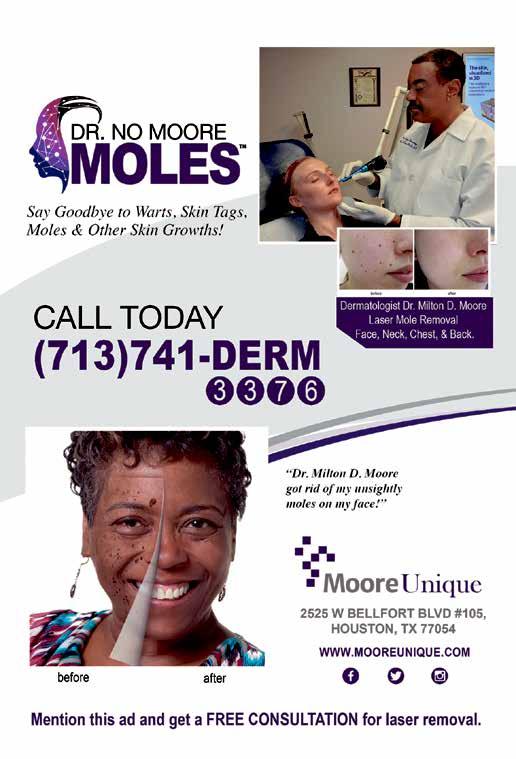
For several years at Moore Unique Dermatology & Spa, I’ve been using a special surgical laser technique that can achieve excellent results in treating moles in as little as 30 minutes.
I begin each outpatient procedure by applying numbing cream to the face, so patients feel little to no pain as I apply the laser to each skin growth. Recovery takes about two to three days as the treated moles simply dry up and shed. In about two to three weeks, natural skin color returns to the treated areas for a smooth complexion with no evidence the moles were ever there.
Are you ready to take your appearance from bumpy to better?
If so, schedule an appointment with Dr. Moore today. Call (713) 741-DERM (3376) or visit his Unique Dermatology website at www.uniquedermatology.com
Dr. Milton D. Moore is a dermatologist, pharmacist, and developer of the Moore Unique Skin Care line. Dr. Moore began his career as a dermatologist in Houston in 1985. He started his own private practice, Moore Unique Laser Surgery and Dermatologic Care, which has evolved into Moore Unique Dermatology & Spa. In addition to being a successful business owner, Dr. Moore is also an inventor and developer and holds numerous patents in regards to his skin care line. While his practice generally focuses on the treatment of minorities and the dermatological conditions and diseases that disproportionately affect at-risk populations, Dr. Moore’s products are also designed for the general population. In 1990, he patented and developed the Moore Technique Shaving System and received the only patent for treatment of Pseudofolliculitis Barbae (PFB), commonly known as razor bumps.

Are you ready to take your appearance from bumpy to better?
If so, schedule an appointment with me today. Call (713) 741-DERM (3376) or visit my Unique Dermatology website at www.uniquedermatology.com
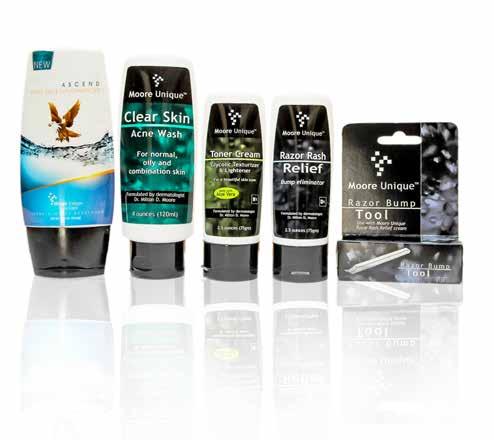

According to a recent study by the Pew Research Center, a majority of Black Americans (61%) now say they plan to get a COVID-19 vaccine (or that they’ve already received one), compared to only 42% in November, 2020. As trust increases, we need to also increase access to COVID-19 vaccinations and testing in our communities to create better health outcomes.
By Dr. Benjamin F. Chavis Jr. NNPA NewswireThe COVID-19 pandemic across America and throughout the world is still a serious danger to public health for all communities, but especially for African American and other people of color communities. African Americans are still disproportionately negatively impacted by this deadly virus.
This is why more COVID-19 testing for Black America is so important in 2021: African Americans comprise 13% of the U.S. population, but more than half of all COVID-19 cases, and nearly 60% of all COVID -related deaths in the U.S., were in cities with large Black populations. Now that federal-government approved vaccines are available, it does not mean that COVID-19 testing is no longer needed.
The National Newspaper Publishers Association (NNPA) is very concerned about the current state of health disparities and inequities that are realities for the majority of African Americans. Facts, data, and truth about the pandemic are vital to our future.

According to a recent study by the Pew Research Center, a majority of Black Americans (61%) now say they plan to get a COVID-19 vaccine (or that they’ve already received one), compared to only 42% in November, 2020. As trust increases, we need to also increase access to COVID-19 vaccinations and testing in our communities to create better health outcomes.
The Black Press and the Black Church are two
fundamental trusted institutions in our communities. We are pleased to learn about a new emerging partnership with Black church leaders which is creating greater access to much-needed COVID-19 testing in our communities. A partnership between Quest Diagnostics, Choose Healthy Life and the United Way of New York City is bringing COVID-19 testing and education to Black communities
and Black people experience risk factors that contribute to heart disease like high blood pressure, diabetes and high cholesterol more often and earlier in life compared to White people. Thus, overall healthcare testing is needed throughout Black America.
Getting tested for important health issues - and understanding the results - empowers people to make informed and sometimes critical healthcare decisions. In fact, 70% of medical decisions are based on results from diagnostic tests. Because there aren’t always obvious symptoms of a health issue, testing is one of the most effective ways to identify health concerns that may need to be addressed.
in cities across the U.S., and they are working with trusted voices in Black churches to increase participation.
The pandemic has also made it even clearer that Black Americans need access to additional resources to take control of their health. In Chicago for example, Black residents make up 30% of the population but account for 70% of COVID -related deaths, and the majority of Black COVID-19 patients who have died in Chicago also had underlying health conditions, like respiratory problems, hypertension, high blood pressure, and diabetes.
According to the Centers for Disease Control, heart disease is the leading cause of death for Black Americans,
Quest Diagnostics is committed to creating partnerships with others to increase access in Black and other underserved communities. It’s time for the entire healthcare system to step up with similar commitments – with access to treatment and preventative care – to help Black communities move past this pandemic on an even ground with White America. Access, testing, and equity are keys to achieving and maintaining good health for all.
Dr. Benjamin F. Chavis, Jr is President and CEO of the National Newspaper Publishers Association (NNPA), and Executive Producer and host of The Chavis Chronicles (TCC) on PBS TV stations weekly across the United States.
Source: NNPA
More than a year into the COVID-19 pandemic, it’s becoming clear that some patients
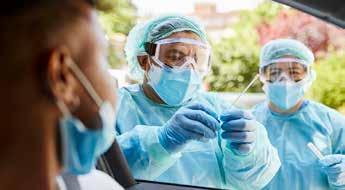
president and chief clinical officer, Cigna.
Dr. Miller, a nationally-recognized advocate for greater access, affordability and excellence in health care, is offering the following tips for those grappling with “Long COVID.”
1. Take care of your mental health: It’s no secret that we’re facing a mental health crisis in America that will remain long after COVID-19 restrictions are eased. Last year alone, Cigna’s pharmacy benefit manager saw a nearly 8 percent increase in people using antidepressants. Recovery from COVID-19 can be physically and mentally draining, especially for people whose symptoms persist for many weeks or months.
Cigna research shows at least 5 percent of its patients who recovered from COVID-19 developed a mental
health disorder in the following months. The good news is that the pandemic has rapidly accelerated the availability and adoption of a range of behavioral health options, making it easier to find a mental health counselor who can help. In fact, 60 percent of Cigna behavioral health customers are now using virtual services –97 percent of which had previously never had a virtual visit before the pandemic.
2. Take advantage of care managers: Many health plans have expanded access to virtual and telehealth services that can help you avoid additional trips to the clinic or emergency room. Equally important, some health plans offer individualized support in your recovery from a “care manager.” Think of them as a personal health advocate. They will check in to see how you’re feeling, help connect you with needed specialists and follow-up treatments, and will even check in on your family. Hospitalized Cigna customers who had a post-discharge visit with a provider, either in-person or virtually, and engaged with a Cigna care manager, saw savings of almost $2,000 in 60-day post-COVID costs. Care managers also helped people recover and return to work a full week
sooner than average.
3. Get vaccinated when you can. Some preliminary reports show that getting the COVID-19 vaccine has helped improve symptoms for long-haulers.
4. Find a “long-hauler” clinic. Researchers are still learning about COVID-19’s long-term impacts, and there are a number of clinics opening across the country focused solely on treating COVID long-haulers. The National Institutes of Health has also dedicated $1.1 billion to the study of “Long COVID,” and Cigna is coordinating closely with them and these clinics to support its customers. Connection is crucial, so also consider seeking out an online long-hauler support network like Survivor Corps.
5. Keep practicing COVID-19 precautions. Everyone is ready to get back to doing the things they love, but none of us are safe until all of us are safe. America is in a race to reach herd immunity before more contagious variants gain momentum. Continue wearing masks, washing your hands and practicing social distancing and encourage family and friends to do the same.
Source: StatePoint